
Heuriger: Wine-culture in Vienna
| It is spring in Vienna. Green is predominant and trees and bushes blossom, so that you seem to be living in a colourful explosion. The air is clear. I am standing near the top of Bisamberg and can see as far as Slovakia to the east, to the south I am really able to see Rax and Schneeberg, both being at least seventy, eighty kilometers away. I can see the white snow on top of Schneeberg, which has an altitude of over 2000 m anyhow. The Bisamberg, to the north of Vienna, has with its 364 meters a more moderate measure, but the real difference in height to the city below, is about 200 meters, more than enough for a spectacular view. On the hillside, leading townwards, there is one vine close to the other, in seemlessly neverending rows.
|
 |
I start descending slowly and come to think of that the vineyards here have ancestors back into Roman times, at least some 2000 years ago. The tradition that the vine-dresser sells his wine to passers-by is probably as old. But not before 1784 this right was to be constituted by law, when emperor Joseph II declared that the Viennese vine-dressers had the right to sell provisions, such as wine from own production, if this was done in the same house, where the wine from the nearby vineyards hade been pressed. This is interesting because of two things: The first is, that it said provisions from own production, which makes it possible to sell something to eat with the wine. This consists today of a lot of good-looking, good-tasting delicacies (which not always must be that healthy, though). The second thing is, that the imperial law necessarily confines the "Heurige" to the foot of the hills around the city.
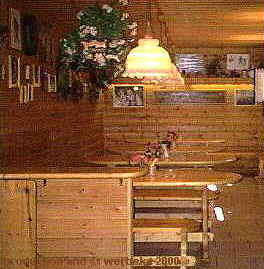 |
|
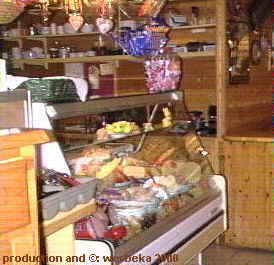 |
| This is, how it might look indoors at a "Heuriger". And near the counter you will always find something delicate to eat with the wine.
|
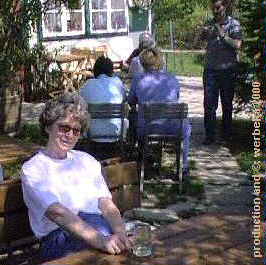 |
|
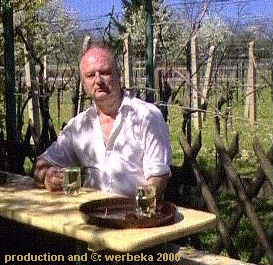 |
| Here are two examples of gardens. And the wine really tastes best under the sky, if the weather permits.
|
In foreign countries the most well-known places are Grinzing and maybe even Sievering and Nussdorf, because busloads of tourists are delivered there. You are supposed to go in somewhere to get "ein Vierterl", this is to say a quarter of a liter wine, which they had promised you in the broschure, and while drinking it, you listen to a couple of typical Viennese songs, interpreted by more or less skilled musicians. Then it is time to get into the bus again, to be rushed to the next attraction. But this has very little to do with the real atmosphere at a "Heuriger".
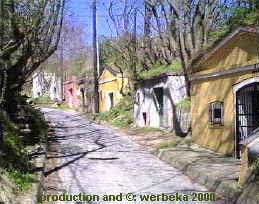 |
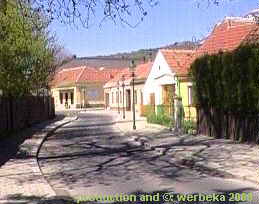 |
An alley with lots of wine-cellars, on the way down from Bisamberg. And a lane downtown in Stammersdorf. Here you won't find any tourist busses yet, and this is why you still can find genuine atmosphere around.
|
Personally - and I stand not alone among the locals - I prefer the old towns north of the Danube, at the foot of the Bisamberg, like Strebersdorf and Stammersdorf. The wine is at least as good there and people feel happy without any artificial help.
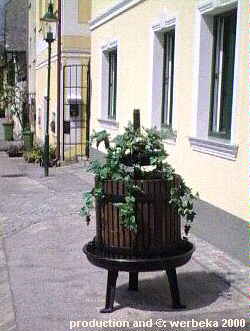 |
You are reminded of the work of the vine-dressers, wherever you go. Here in the form of an old winepress, standing on the pavement.
To pay a visit to the "Heuriger" is part of everyday-life in Vienna, people go there a lot oftener than they go to an sporting event or to the theatre. I come to think of that the name as well as tradition goes back to the Romans. "Heuriger" means "this year's" and of course it was used for the wine-harvest of the year, even if it today also signifies the place where the wine is sold. The word is derived from "heuer = this year", a word which isn't used in common German, but only in Bavarian-Austrian dialects. There is, however, a similarity, which is used all over the German speaking area: "heute = today". The word comes from Latin "hodie", which in its turn is an abbreviation of "hoc dies", which unsurprisingly also means "this day". It is funny to find one of the words everywhere, whereas "heuer" more or less is used in Austria only. On the other hand, it is there, where there are "Heurige".... |
|
Aaron Krolikowski has made some sketches at a Heuriger in Vienna, and gave me, kindly enough, the right to show them on my pages. If you wish to see the other sketches, just click onto the image.
It isn't at all usual, that any "Heuriger" keeps open all year, it is entirely up to them to decide on their own, when they would like to sell their wine. Whereas the bigger ones have fixed dates, as e.g. every second month, and others specialize on weekends, e.g. Friday to Sunday, it isn't very unlikely that the owner of a small "Heuriger" will answer your question about opening times with: "if the weather is nice..."
|
|
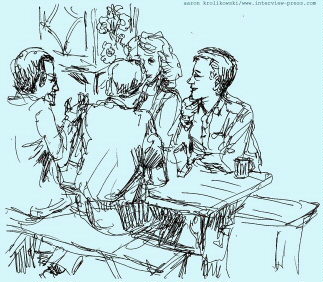 |
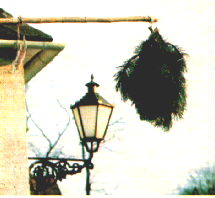 |
This bunch of pine-twigs shows from afar, that this place is open.
That doesn't matter too much, though, because there are a lot of places around, and you'll always find some open ones, notwithstanding when you want to go. At any time of the year you will find the bunch of pine-twigs in front of someone's door. This is the common signal, used by everyone, to show that it is open. In Vienna it is called: "ausgsteckt is".
Because of those bunches ("bunch" = "Busch") a "Heuriger" can also be called a "Buschenschank". |
It is a long time since I have been living in Vienna, so I don't remember all the alleys leading down to the villages. In everyone there are a couple of "Heurige" and it is easy to lose your way. Still, you can't get lost, because as long as you go downwards, it will be the right direction....
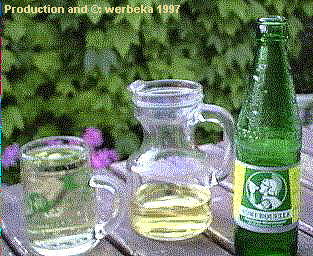 |
It is, of course, possible to order wine and water an mix your own blend of "Gspritztn".
By this time I feel very thirsty. If that depends on my stroll or on my thinking of wine all the time - I don't know, but I decide to drop in at the next "Heuriger" and have a "Gspritztn". This wonderful Viennese word with eight consonants and just one vowel in the middle of it (not even slavic languages can compete), this word means one eighth of a liter wine mixed with as much water. This refreshment has become very popular during the last two decades. Partly because it is more refreshing, partly because you don't get drunk as fast. |
|
The next "Heuriger" happens to be the vinery of the Lang family. They have just opened and I am the first guest. That is why I ask if I may take some pictures. And I may. The part indoors is hewn into the mountain and might have been a wine-cellar before. But as almost everywhere, here too is an outdoor-serving, which in this case is situated "on the roof", to save some space. I sit down in the garden and relax for a while. The simple, wooden tables and benches are a tradition at the "Heurige", it is the wine that should make you comfortable instead. |
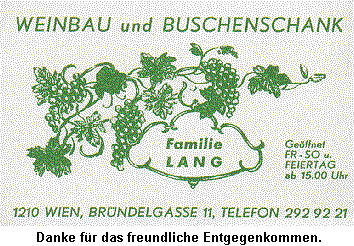 |
It is really a little early in the year, but later on, it might be difficult to find a nicer surrounding to be sitting in, when the vines all around you have grown leaves and when the grapes hang down from them in the autumn.
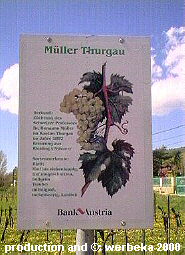 |
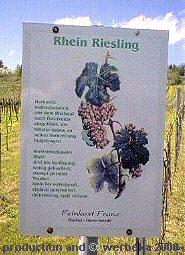 |
While I am drinking my wine, more visitors keep coming and soon the air is full of that sort of sound, which is so typical for happy and content people.
When I finally continue on my walk downtown, I pass some vineyards, where they - in a very educative manner - have placed information on what kind of grapes are grown there. I read about the different sorts - but at the same time I recognize that it doesn't really matter that much, if you drink a "Grüner Veltliner", a "Müller-Thurgau" or a "Neuburger". At a "Heuriger" all sorts taste good. |
Back to  or to the or to the  of of 
8.1.2008 by webmaster@werbeka.com
|

















